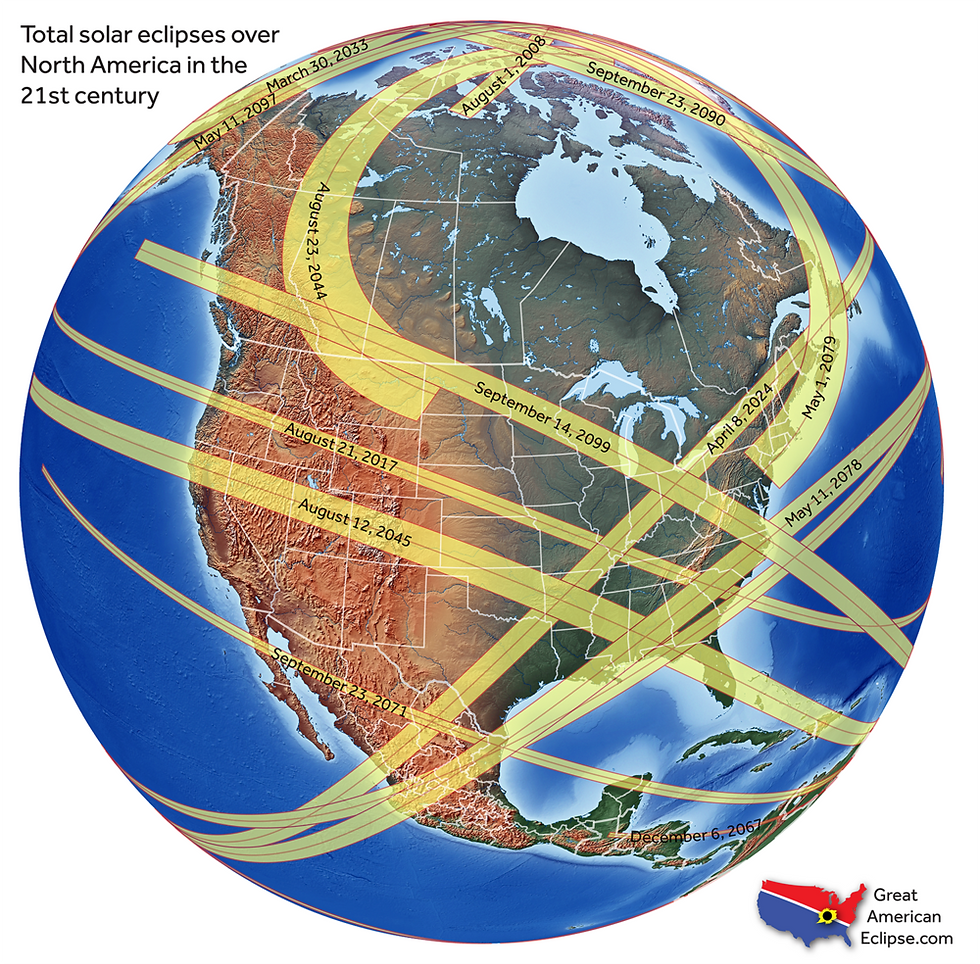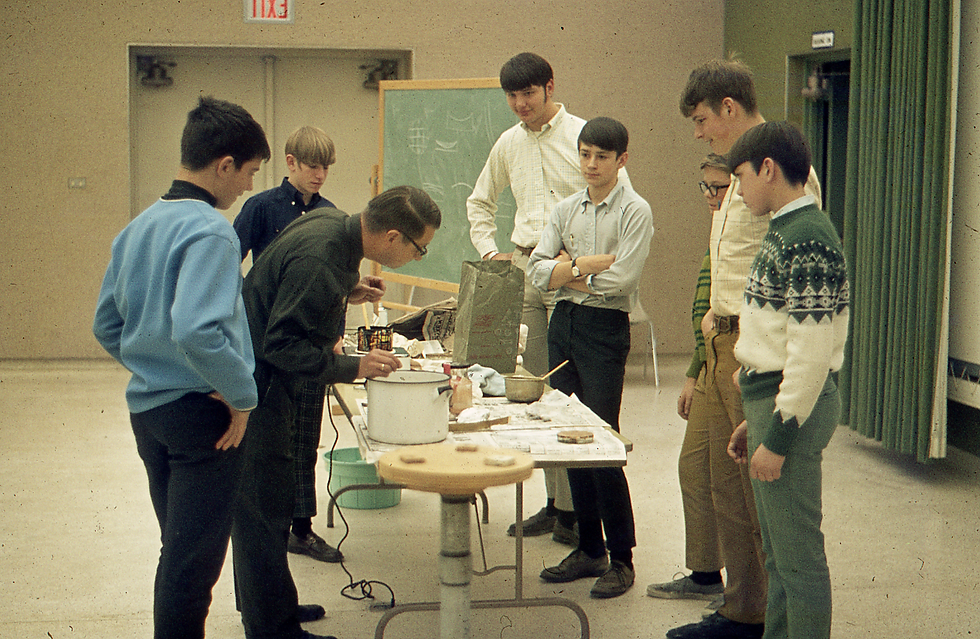Looking Back - The Great American Eclipse of August 21, 2017
- Dave DeBruyn
- Oct 6, 2017
- 7 min read
The total solar eclipse of August 21st has come and gone. What a memorable adventure it turned out to be for those from West Michigan and far beyond who ventured to the path of totality somewhere between Oregon and South Carolina. Almost all the groups I have heard from were successful in their quest to stand under the moon’s passing shadow, though there were some close calls. Adjectives such as "surreal," "spiritual," and "inspirational" were common in describing this seldom witnessed natural spectacle.
I was leader of a large organized group that included current and past members of the Grand Rapids Amateur Astronomical Association and friends old and new. We had begun our planning last winter to assemble at a historic airfield near the village of Fairmont in eastern Nebraska. Anticipation to witness what many consider nature’s greatest spectacle with roughly 75 “family and friends” came apart rapidly the night before the big event. As we gathered for a briefing at our Lincoln, NE lodging site, WOOD-TV8 meteorologist Ellen Bacca, who had joined us there, delivered the discouraging news that converging forecasts called for 60 percent cloud cover at our selected site.
A dilemma faced participants: chance it under questionable conditions, or head further west, where clearer skies were forecast? Even as Ellen was speaking, many pored over maps, working up alternate itineraries, and soon were heading out for a long trek through the night. Shunning sleep, they began heading toward locations within the path of totality up to four hundred miles further west, such as Alliance and Scottsbluff, NE, and even to Glendo State Park in Wyoming. They would not return to the lodge (exhausted, but elated) until late into the following night.
Those of us deciding to take our chances near Fairmont retired to a night of fitful uncertainty, opening curtains on eclipse morning to a scene of mostly cloudy skies. It was good to find expected traffic jams getting to our site–about 50 miles away–non-existent. As we set up lawn chairs and observing equipment, the sun teased us into guarded optimism by poking in and out through breaks in the clouds.
Our splintered group, now down to about about 40, was joined by eclipse chasers from all over the country, including others from West Michigan. We were also joined by former (and now rejoining) GRAAA member Andrew Harwood and his delightful family, who reside near Minneapolis. There were an estimated 1,000 expectant viewers at the Nebraska State Airfield.

Figure 1: Family and Friends Group in Nebraska.
Photo credit: David Staskiewicz
Wonderful conversations ensued as we collectively and anxiously glanced skyward. As “first contact” (the moment when the passing moon takes its initial bite out of the solar disk) drew near, high clouds blurred the view, with more ominous ones in the distance. Amazingly, as in past solar eclipses I have witnessed, first contact came exactly at the predicted time. The moon’s orbital motion is so precise that this moment had been known for centuries.
My attention was first drawn to the remarkable 2017 "Great American Eclipse" while I was in college in the early 1960’s. I had been anticipating this coast-to-coast eclipse ever since, and once again the obscuring body was right on schedule. Totality was still nearly an hour and a half away but progression toward that dramatic climax had begun.
High clouds continued to affect viewing, with moments when the sun was completely obscured by mid-level cloudiness. One could sense an eerie pall descending over our group as sunlight decreased and cloudiness increased. On the horizon, the unmistakable signature of rain shafts descended from one dark cloud.
I have seen five total eclipses during my long career, so disappointment would not cut as deep as it would for so many first-time viewers whom I had enticed to join me with tales of a very special experience and admonishment: “You have to see this!”

Figure 2: Partial horizon panorama about 30 minutes before Totality.
Photo credit: David Staskiewicz
With about 15 minutes to go came signs of hope. A substantial clear patch was drifting in the proper direction. The sun, by now narrowing to a thin crescent, was casting weak but more distinct shadows. Spirits rose as it centered within the clear patch. Would that drifting patch of blue sky stay in place long enough?
As I alternately gazed through a telescope eyepiece and then upward with the naked eye, (with my eclipse glasses on, of course) I found myself urging the moon to speed up. Please cover the whole sun now! Let’s get on with this before clouds move back in! Friends were encouraging. “We’re going to see it Dave!”
They were right! As the final brilliant edge of the solar disk began to disappear, I looked toward the northwest to behold a black curtain more menacing than any approaching storm. It was the moon’s shadow, racing toward us at more than 1,600 miles per hour. In an instant, it enveloped all of the sprawling airfield, producing a transformation that elicited a collective gasp from the multitudes gathered there.



Figures 3-5: Ambiance midway to, just before, and during Totality.
Photo credit: Ken Katerberg.
We were suddenly plunged into a deep twilight, while up in the sky, as within a blackened cone, the totally eclipsed sun was surrounded by a brilliant irregularly shaped halo, the solar corona. This is the super-heated outer atmosphere of the sun, which hides in the solar glare except during brief moments of total eclipse. Within it are delicately structured streamers produced by the powerful magnetic field enveloping the sun.

Figure 6: Corona with streamers.
Photo credit: Joe McBride

Figure 7: Inner corona with prominences.
Photo credit: Andrew Harwood.
Through the telescope I could see usually-invisible eruptions called prominences and an intense crimson layer of atmosphere, the chromosphere. It was mesmerizing. The above images were taken by astrophotographers from our group who really know what they are doing. I could have included so many more if there was room in this post, but you can view more in our Flickr pool or on Facebook.
Fortunately, I pulled away from the eyepiece long enough to use part of the vanishingly short 2.5 minutes of totality to look around the horizon. The twilight glow that surrounded us was more unique and beautiful during this eclipse than in any other I have witnessed because there was little in the way of nearby hills or structures to obscure the view.

Figure 8: Partial horizon panorama during Totality.
Photo credit: Andrew Harwood
The unique 360 degree glow is caused by weak sunlight falling on features outside the 60 mile diameter shadow. You have to see this effect in person to fully appreciate it. Above the landscape were clouds painted in an array of pastel pinks and various shades of violet. Compare Figure 8 to Figure 2 to better understand how ominous clouds that could have wiped us out ended up adding significantly to the impact of the event.
Turning back to the telescope, I could see a distinct brightening along one edge of the dark moon. This celestial show would soon end with the grand finale we were anticipating. I looked up just in time to see a rapidly swelling burst of light, the amazing “diamond ring.” As the bright edge of the sun re-emerged, the corona and planets Venus and Jupiter (which had emerged into view during totality) faded away. Applause and wild jubilation erupted all around.

Figure 9: Diamond ring
Photo credit: Mark Boyd
As our group breathlessly reveled in what we had just witnessed, one could almost hear a collective sigh of relief. If you look closely at Figure 9, you can see high clouds moving back in. We had been mighty fortunate.
Reports from friends who fled west tell similarly awesome–though less anxious–tales of success. West Michigan eclipse chasers who elected other locations in southern Illinois, Kentucky, and even Tennessee, were also mostly successful. Particularly impressive is Figure 10 below, of the inner corona showing remarkable structure.

Figure 10: Inner corona with detail.
Photo: Duane and Katie Weller.
My sister Sandy and her entourage in South Carolina blessedly did not have to travel at all. The moon’s shadow passed right over her home on Lake Murray near Columbia as she and "Family and Friends –East" looked upward in wonder at their first total solar eclipse from cooling waters on the 95 degree day.


Figures 11-12: GRAAA Family and Friends East.
Photo Credit: Terri Pearce.
Most who saw it will forever remember the Great American Eclipse, and many of those folks are already making plans to witness the next one to pass over the United States, coming up in only seven years. On April 8th, 2024, the moon’s shadow will sweep northeastward from Texas to Maine, enveloping Cleveland and Toledo, so the trip to get to the path of total eclipse could be shorter. When I first showed the path of totality to WZZM-13 chief meteorologist George Lessens, who has been consulting with me for over a year on best places to go for the 2017 eclipse, he quickly pointed out that it passes through some of the most storm and cloud prone regions of the country at the worst possible time of year. I, along with family and friends who shared the memorable 2017 eclipse with one another and are now confirmed shadow chasers, will likely be making plans to see the event from southern Texas, where weather prospects are best.

Figure 13: United States total eclipses in 21st century.
Graphic courtesy of NASA.
There will be another coast-to-coast solar eclipse in August of 2045, but I am not banking on seeing that one. The many youngsters who joined us in Nebraska for the big celestial show will hopefully view it as they recall their first first experience under the moon’s shadow in 2017. Some of those kids may also make it to 2099, when for the first time since 1925, the moon's shadow will sweep over parts of Michigan's lower peninsula, enveloping Muskegon, Grand Rapids, Kalamazoo, and Lansing.





Comments